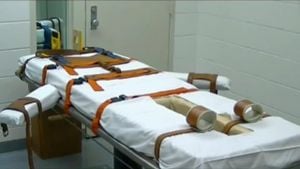A recent wave of drone sightings over U.S. Air Force bases across the United Kingdom has raised significant security concerns among military officials and prompted increased measures from local authorities. The situation, which began to unravel on November 20, 2024, has seen unidentified drones monitored flying above and near multiple military installations, with the potential for serious national security implications.
Specifically, the affected bases include RAF Lakenheath, RAF Mildenhall, and RAF Feltwell, all of which are key U.S. military sites located within the same geographical area referred to as the Tri-Base Area. Another base, RAF Fairford, about 130 miles away, has also reported incursions, which is notable since it is home to several B-52 bombers currently deployed as part of Bomber Task Force 25-1.
The U.S. Air Force has characterized the drones as “swarms of small unmanned aerial systems,” with various sizes and configurations noted across different observations. A senior official from the U.S. Air Forces Europe indicated to Fox News this week, "These don’t appear to be operated by hobbyists; the drones observed are more sophisticated than typical consumer models.” This has led officials to speculate about the possibility of these drones being used by foreign state actors potentially testing the security measures of these military bases.
This growing concern is underscored by the actions taken since the initial sightings were reported. The U.K. Ministry of Defence has deployed approximately 60 British personnel specialized in counter-drone operations to the bases. RAF jets have also scrambled to intercept the drones on multiple occasions. At the same time, the Royal Air Force has been actively engaged with local law enforcement to try and trace the origins and the intent behind these drone activities.
Maj. Gen. Pat Ryder, the Pentagon’s press secretary, addressed the matter during recent briefings, emphasizing the military's focus on safeguarding personnel and assets at the bases. Ryder stated, “None of the incursions have impacted the base residents, the facilities, or U.S. assets on the bases. We are monitoring the situation closely and keeping open channels with local law enforcement to address any concerns.” Nevertheless, the unique nature of these sightings—especially the organized patterns appearing across multiple military installations—has made both American and British officials wary.
Military and aviation experts have weighed in on the legal and logistical challenges posed by such incursions. Flying unauthorized drones within the vicinity of military bases is illegal under U.K. law, but the enforcement of such regulations can be complex, particularly when these bases are located near populated areas. The rapid proliferation of commercial drone technology has transformed the airspace environment, complicitting how militaries can respond to such incursions without risking collateral damage or civilian safety.
The situation is reminiscent of previous drone incursions reported at U.S. military installations, such as those seen at Joint Base Langley-Eustis, Virginia, where surveillance has been stepping up for almost a year due to unidentified drone activity. The Pentagon recorded multiple incursions last year without definitive conclusions about the perpetrators. The concern is not only with preventing drone flights over military airspace but also with the potential espionage capabilities these drones possess, especially with the increased frequency of military operations by hostile nations.
The U.S. Air Force has been exploring less costly, yet effective methods for countering drone threats, as traditional high-cost solutions involving munitions may not be practical. Air base defense strategies have been in flux, signaling the need for adaptive measures to counter what appears to be modern asymmetrical threats.
This developing situation has triggered inquiries from various sectors, including parliamentary discussions around air and missile defense mechanisms. U.K. Member of Parliament Nick Timothy remarked on the need for reassurance among local residents, particularly those affected by late-night scrambles of military jets, which he confirmed have caused public concern. He noted, “We are trying to balance operational security with civilian safety, particularly as residential developments encroach upon military installations.”
Despite the lack of capability from the current drones to impact operations or safety, the defenses implemented at these installations are likely to evolve as both nations continue to investigate the origins and purpose behind these incursions. Local authorities have been urged to remain vigilant and report any suspicious drone activities, with the military coordinating closely with civilian agencies to anticipate potential threats.
With these increasing reports of unidentified drones hovering over key military bases and the speculation surrounding their origins, the incident raises many questions. How states might leverage drone technology for surveillance has become particularly pressing, as the ease of access to sophisticated UAV technology has made traditional military defenses more vulnerable. Each sighting serves not only as a reminder of new technological challenges faced by military forces but also as a clarion call for updated policies regulating drone usage. The collaboration between U.S. and U.K. forces emphasizes the importance of multinational efforts to secure their airspace from potentially hostile incursions as global tensions continue to escalate.
The drone incidents also bring to light questions surrounding international airspace laws and the consequences of unauthorized drone flights. Advocacy for updated regulations may gain momentum, emphasizing the necessity of managing drone usage comprehensively, particularly as this technology continues to proliferate. Any missteps could be costly, not just financially, but also strategically as military forces strive to maintain operational security and safety.
For now, authorities remain on high alert, carefully monitoring every drone activity, engaging law enforcement and military search operations, and investigating the ramifications of these incursions. Vigilance and readiness will be key as the investigation continues, keeping local bases secure amid the unknown challenges posed by modern drone technologies.



